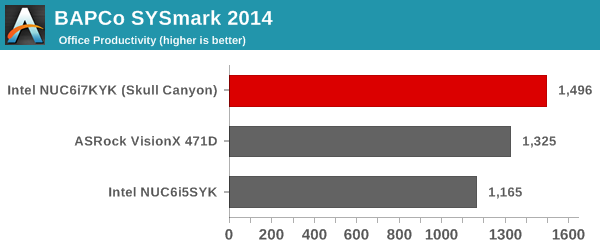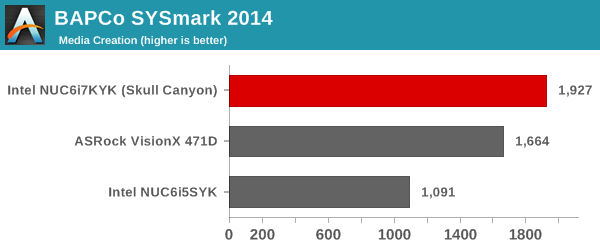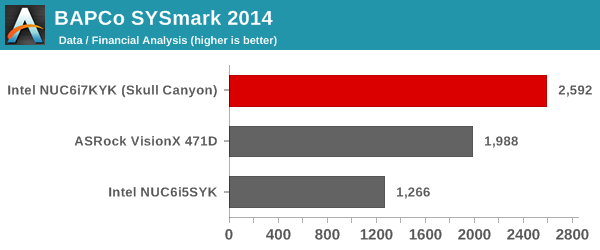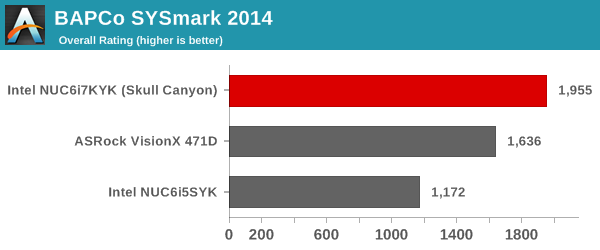The Intel Skull Canyon NUC6i7KYK mini-PC Review
by Ganesh T S on May 23, 2016 8:00 AM ESTPerformance Metrics - I
The Intel NUC6i7KYK (Skull Canyon) was evaluated using our standard test suite for low power desktops / industrial PCs. Not all benchmarks were processed on all the machines due to updates in our testing procedures. Therefore, the list of PCs in each graph might not be the same. In the first section, we will be looking at SYSmark 2014, as well as some of the Futuremark benchmarks.
BAPCo SYSmark 2014
BAPCo's SYSmark 2014 is an application-based benchmark that uses real-world applications to replay usage patterns of business users in the areas of office productivity, media creation and data/financial analysis. Scores are meant to be compared against a reference desktop (HP ProDesk 600 G1 with a Core i3-4130, 4GB RAM and a 500GB hard drive) that scores 1000 in each of the scenarios. A score of, say, 2000, would imply that the system under test is twice as fast as the reference system.




We started using SYSmark 2014 quite recently, which is the main reason for the absence of many of the comparison systems in the above graphs. In any case, the most interesting of the compared lot when it comes to CPU-intensive benchmarks like SYSmark 2014 is the ASRock VisionX 471D, equipped with a Core i7-4712MQ processor. We can see that the Core i7-6770HQ-based Skull Canyon NUC6i7KYK is miles ahead of the other two systems when it comes to office / business workloads. Readers interested in comparing the SYSmark 2014 scores for systems based on other CPUs can peruse the Bench results here.
Futuremark PCMark 8
PCMark 8 provides various usage scenarios (home, creative and work) and offers ways to benchmark both baseline (CPU-only) as well as OpenCL accelerated (CPU + GPU) performance. We benchmarked select PCs for the OpenCL accelerated performance in all three usage scenarios. These scores are heavily influenced by the CPU in the system. As expected, the Core i7-6770HQ enables the NUC6i7KYK to easily come out on top in the charts.



Miscellaneous Futuremark Benchmarks

The graphics benchmarks present a different story, though. In these, the NUC6i7KYK does perform well enough to come in the top half. However, in scenarios which are not CPU-bound, the systems equipped with discrete GPUs easily turn out to be better than Skull Canyon.




3D Rendering - CINEBENCH R15
CINEBENCH R15 is a standard benchmark for 3D rendering. It provides three benchmark modes - OpenGL, single threaded and multi-threaded. Evaluation of select PCs in all three modes provided us the following results.



In the single-threaded case, the Core i7-4770R (a 65W TDP CPU which can turbo up to 3.9 GHz) performs slightly better than the Core i7-6770HQ. However, the latter wins out in the multi-threaded cases. In the OpenGL case, the GIGABYTE system with the discrete GPU wins out, showing that a combination of CPU power as well as GPU is needed to perform well in this benchmark.










133 Comments
View All Comments
spikebike - Monday, May 23, 2016 - link
Anyone know why the GB-BXi5G-760 is so slow? The spec looks pretty similar to the EN970 (same gpu), to performs radically worse on all the games.Calista - Monday, May 23, 2016 - link
Was it not related to heavy throttling? Like *really heavy* throttling.trane - Tuesday, May 24, 2016 - link
Pleasantly surprised by the GPU. Pretty damn good, around the same as a 750 Ti.tipoo - Wednesday, May 25, 2016 - link
I thought it would be more to be honest. Looks like the size of the heatsink is limiting it. It's good, but at nearly double the EUs of the already ok Iris Pro 5200 in my Haswell machine, I expected the 72 EU to do better than this.potf - Tuesday, May 24, 2016 - link
Missing Noise levels in anandtech reviews, with the thermals ?The product maybe has a target, which is not me, but the problem with the mini pc reviews at anand is that we only get 1 or 2 little measurements on the fan noise, and in the skull canyon Nuc, I think it's disappointing, as you mention it in the final comment
> " We would gladly trade a modest increase in the footprint of the system for lower fan noise. That said, the fan noise is in no way comparable to the BRIX Gaming lineup. It is just that it is not as silent as the traditional NUCs."
For example, measuring noise at idle, at gpu / cpu loads, and getting a noise comparison at these points would be useful : the thermals are very nice, but you cannot compare them really/easily from one pc to the other.
My point is that with the current idle power at 17 watts in your test, this racehorse nuc is never ever silent or even quiet, but I would like to see comparisons with the other nucs or at least the MSI cubi 2 recently reviewed.
Also curious about the noise level of the asus VC65 / VC65R relative to that of the Skull Nuc ;), what I mean is that the chosen form factor can be either optimal, or poorer than other 35W-45W solutions.
Will we be getting noise comparisons betwen PCs in a nice chart soon ?
Osamede - Tuesday, May 24, 2016 - link
I'm asking: what is the use case that Intel are targeting and marketing to? Is it 1080P?milkod2001 - Tuesday, May 24, 2016 - link
I'd say the only NUCs which make sense to buy are the cheapest options(not the one reviewed here). Good enough for office work, youtube, Facebook and internet browsing.For gaming or serious work laptop or mini ATX build will give user much much more than this overpriced fancy NUC
rhx123 - Tuesday, May 24, 2016 - link
So disappointed. I was really looking forward to this product, but the PCIE/DMI Situation is incredibly silly. Must be intentional, but why?Such a waste.
Femton - Tuesday, May 24, 2016 - link
What is your comment to jasonelmore who earlier ( Monday, May 23, 2016) that "it will work fine. Intel has been using the Razer External GPU Chassis and they even commented on it here on Anandtech Comments, on the last article that was posted about it. DMI 3.0 still does 4GB/s and the CPU is not transferring huge amounts of bandwidth hungry texture data back and forth with the CPU." ?Osamede - Tuesday, May 24, 2016 - link
Noise focus is something that has been a weakness here for some time. And not much awareness from the folks who run this place about it.SPCR is a better place to find what you are asking about. Intel is one of their sponsors, so no doubt they'll have a review up before long.